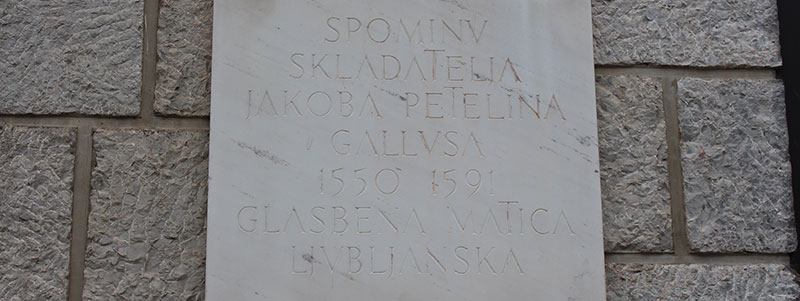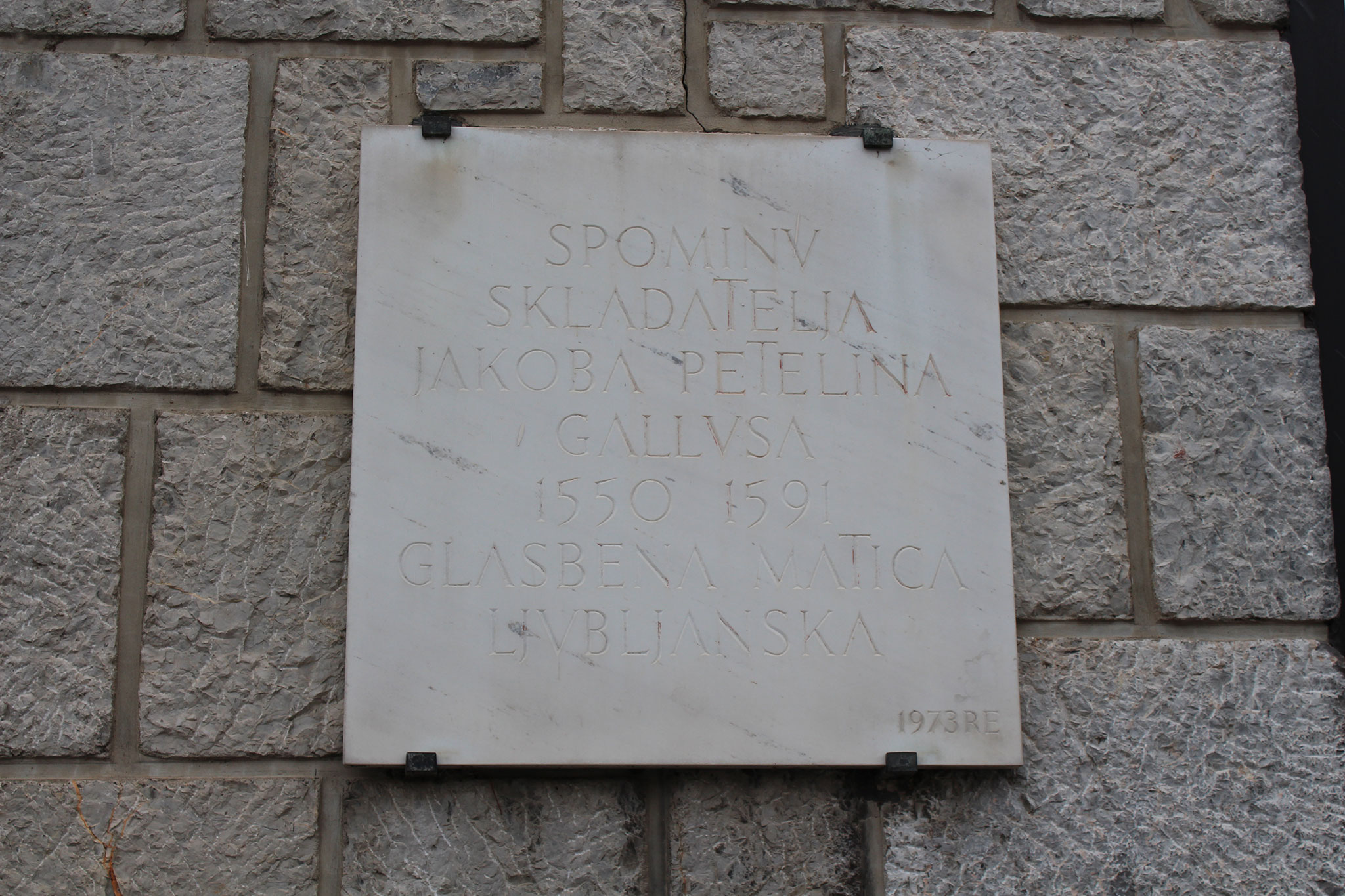The original commemorative plaque attached to the former girls’ school in 1933 was destroyed during World War II. In 1973, a new one was put up on the façade of the Community Centre in the town centre of Ribnica. The timeworn inscription reads:
IN MEMORY OF
COMPOSER
JACOBUS HANDL
GALLUS
1550–1591
MUSICAL SOCIETY
LJUBLJANA
1973 RE
Jacobus Handl Gallus
One of the leading figures of Renaissance music, Jacobus Handl Gallus (1550–1591) is widely considered to be the greatest Slovenian composer. Fully deserving his formidable reputation, this musician left one of the most extensive and treasured musical legacies of the late sixteenth century and ranks among some of the finest composers of his time, contemporaries as distinguished as Giovanni Pierluigi da Palestrina and Orlando di Lasso who, however, enjoyed greater international renown. All three composers artfully navigated the limitations imposed by liturgical reforms and the rich stylistic diversity that was the hallmark of music in High Renaissance. Aiming to conform to the aesthetic norms established in the liturgical practice of the time, Gallus made use of a variety of compositional techniques and styles. Well conversant with the dense polyphonic style of the Franco-Flemish School, as well as the then-new polychoral style, he artfully blended the two, paying special attention to tone painting and contrasting sound structure. His prolific output comprised both liturgical and secular music – over 500 works, for small and large choirs, as well as multiple choirs of up to 24 independent parts.
Many details surrounding Jacobus Gallus’ life remain shrouded in mystery. He was born in 1550; the precise location of Gallus’ birthplace is, however, still the subject of some dispute, and various theories exist regarding the composer’s early biography. Three Slovenian towns, Ribnica, Idrija and Šentviška Gora, are purported to have been his birthplace, but musicologists’ arguments are yet to be supported by conclusive evidence. Since Gallus often added the adjective Carniolus to his name, we may deduce that he was most probably born in the Duchy of Carniola. The surname Handl and the assumed pseudonym Gallus are German and Latinised names, respectively, both versions of the Slovenian surname Petelin, which the composer never used.
In the forewords to printed editions of his works, he often wrote that he had been pursuing music since he was a boy. It is likely that he spent his youth in a monastery, most probably at the Cistercian monastery in Stična, where he might have been provided with his earliest musical education. The composer received an education in humanities, with an emphasis on music, but also studied other subjects comprising the so-called ‘seven liberal arts’. Before 1580, he lived for some time at the Benedictine Melk Abbey, which boasted an impressive music chapel and had numerous patrons who sponsored cultural events and were particularly eager to foster musical activities. The highly stimulating environment certainly encouraged Gallus to devote himself more to composing.
After leaving Melk, Gallus stayed at several monasteries in Austria and Moravia. In 1580, he was appointed choirmaster to the bishop of Olomouc, Stanislav Pavlovsky, but resigned after five years due to growing dissatisfaction with his situation.
At Olomouc, Gallus not only composed, but also supervised choir practice, conducted the singers and attended to the music chapel’s repertoire and quality of vocal delivery. Sometime later, he settled in Prague, where he worked as a choirmaster to the Church of St. John in the Balustrade until his death in 1591. At the time, the cantor of a music chapel, i.e. the choirmaster, was also expected to compose music for the choir. According to the composer himself, his music was heard at the Church of St. John almost on a daily basis. Although he was charged with a whole set of responsibilities, it seems that his main priority was music – composing, printing and distributing his works.
His output includes the most prominent late sixteenth-century musical forms: mass, motet and madrigal. In practice, these polyphonic vocal compositions were often performed to instrumental accompaniment, with the instruments frequently being used to duplicate or replace individual parts. The bulk of his oeuvre comprises sacred music, i.e. masses and motets. In 1580, sixteen of his masses were published in a collection titled Selectiores quaedam missae. In composing masses, Gallus mainly utilised the parody technique, a technique widely practised among sixteenth-century composers: he borrowed various segments of, or even the whole of, a pre-existing polyphonic composition and subjected it to variation in diverse ways, thus reworking it into a new mass setting. He used his own pieces for this purpose, as well as pieces by German, Swiss, French and Flemish masters of the 16th century. It was especially the style of the latter that proved highly influential on Gallus’ own work.
Gallus’ most extensive sacred work, Opus musicum, is a collection of motets, polyphonic compositions based on liturgical Latin texts. Published in four volumes between 1586 and 1591, the monumental work includes 374 motets arranged to cover the needs of the entire liturgical year. It includes Gallus’ most well-known work, the notable Ecce quomodo moritur justus (Behold How the Righteous Perish), which attracted a lot of public attention and enjoyed popularity already in the composer’s lifetime. Its widespread acceptance in both Catholic and Protestant countries can be attributed to its simple structure, homophonic texture, the declamatory nature of the melody on the one hand, and, on the other hand, its tense, expressive, harmonic fabric. Technically undemanding on account of its simple structure, the composition at the same time followed the dictates, that is to say limitations, imposed by both the Council of Trent and the Reformation, which favoured a plainer musical texture instead of a more elaborate one with a view to rendering the text readily intelligible. The motet’s striking concords have ensured that the piece remains of contemporary relevance.
In his final years, Gallus worked on his secular output, a collection of madrigals entitled Harmoniae Morales. The madrigals were settings of secular Latin texts (of a moral and satirical nature) by Ancient Roman poets and Gallus’ fellow humanists. Five years after the composer’s death, his brother George Handl published the remainder of the previously unpublished madrigals under the collective title Moralia.
In his compositional style, Gallus blended the traditional polyphonic style of the Franco-Flemish School (he was a true master of counterpoint) with the new stylistic currents of his time, by utilising polychoral writing, frequently employing a homophonic and chromatic style of composition and the illustrative device of madrigalism. He gave shape to a singular and advanced musical idiom whose main characteristics are an original harmonic structure, an emphasis on sonority (timbres and contrasts) and particular stress on text delivery. The musicologist Dragotin Cvetko points out that none of the elements in Gallus’ compositional texture were self-sufficient or employed for their own sake, but always in the service of overall expression. His enduring legacy still forms part of the current repertoire and continues to honour the composer’s eternal vow to music, “I studied music, I absorbed it into my system, or rather, suckled it from my mother’s breast, I cultivate it as a mature man, and shall, God willing, enrich it still as an old man; I shall remain faithful to it both in life and death”.
Vesna Venišnik

